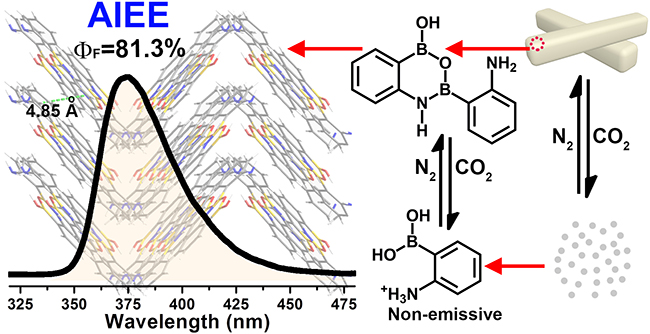Aggregation-induced enhanced emission (AIEE) molecules, novel luminescent materials with high solid-state emission efficiencies, are important in the applications of optoelectronics, biomedical probes and chemical sensors.
Most aromatic AIEE molecules have complex structures consisting of multiple aromatic rings and/or polycyclic skeletons.
Recently, Prof. QING Guangyan's group from the Dalian Institute of Chemical Physics (DICP) of the Chinese Academy of Sciences (CAS) found that 2-aminophenylboronic acid (2-APBA) with a simple structure was highly emissive in the solid state. They further revealed that 2-APBA exists in a dimeric form, and the 2-APBA dimer is a novel AIEE molecule.
This work was published in Chemical Science on August 18.

The 2-APBA dimer tending to aggregate into a highly ordered structure is AIEE-active (Image by LI Xiaopei)
"We are glad to find that a small and simple molecule, because of the ordered aggregation, could emit extraordinary strong fluorescence with high absolute quantum yield," said Prof. QING.
The researchers applied 2-APBA in sensing CO2 based on its reversible AIEE fluorescence quenching and recovery, and disclosed new kind of dynamic covalent B–N and B–O bonds. They proposed a strategy to fabricate a CO2-responsive nano-gating system based on the dynamic covalent B–N and B–O bonds.
This work was supported by the National Natural Science Foundation of China, DICP Innovation Funding, and the Liaoning Revitalization Talents Program. (Text by LI Xiaopei)